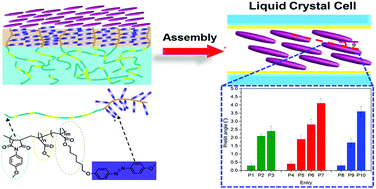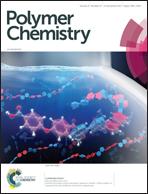Control of the alignment of liquid crystal molecules on a sequence-polymerized film by surface migration and polarized light irradiation†
Abstract
The alignment of liquid crystals (LCs) is the key technology in LC displays, molecular switches and optical systems. Azobenzene (azo) molecules are often incorporated into LC alignment polymer films to make them photoresponsive and thereby anisotropic for light induced alignment; however, in most cases azo-containing materials suffer from the limitation of low thermal stability and poor transparency. We adopted a sequential addition method and synthesized sequence-controlled terpolymers with a terminal azo-containing segment via atom transfer radical polymerization. The control of LC alignment could then be realized by annealing-induced surface migration and polarized-light-induced alignment of azo units in the films of these terpolymers. Terpolymers derived from methyl methacrylate, N-p-anisylmaleimide and 6-[4-(4′-methoxyphenylazo)phenoxy]hexylmethacrylate exhibit excellent transparency, thermal properties, as well as a good LC alignment ability. We demonstrate that sequence-controlled polymerization is useful for precisely controlling the location of functional features along the polymer chain, and thus accurately regulating the properties of the copolymer obtained.



 Please wait while we load your content...
Please wait while we load your content...